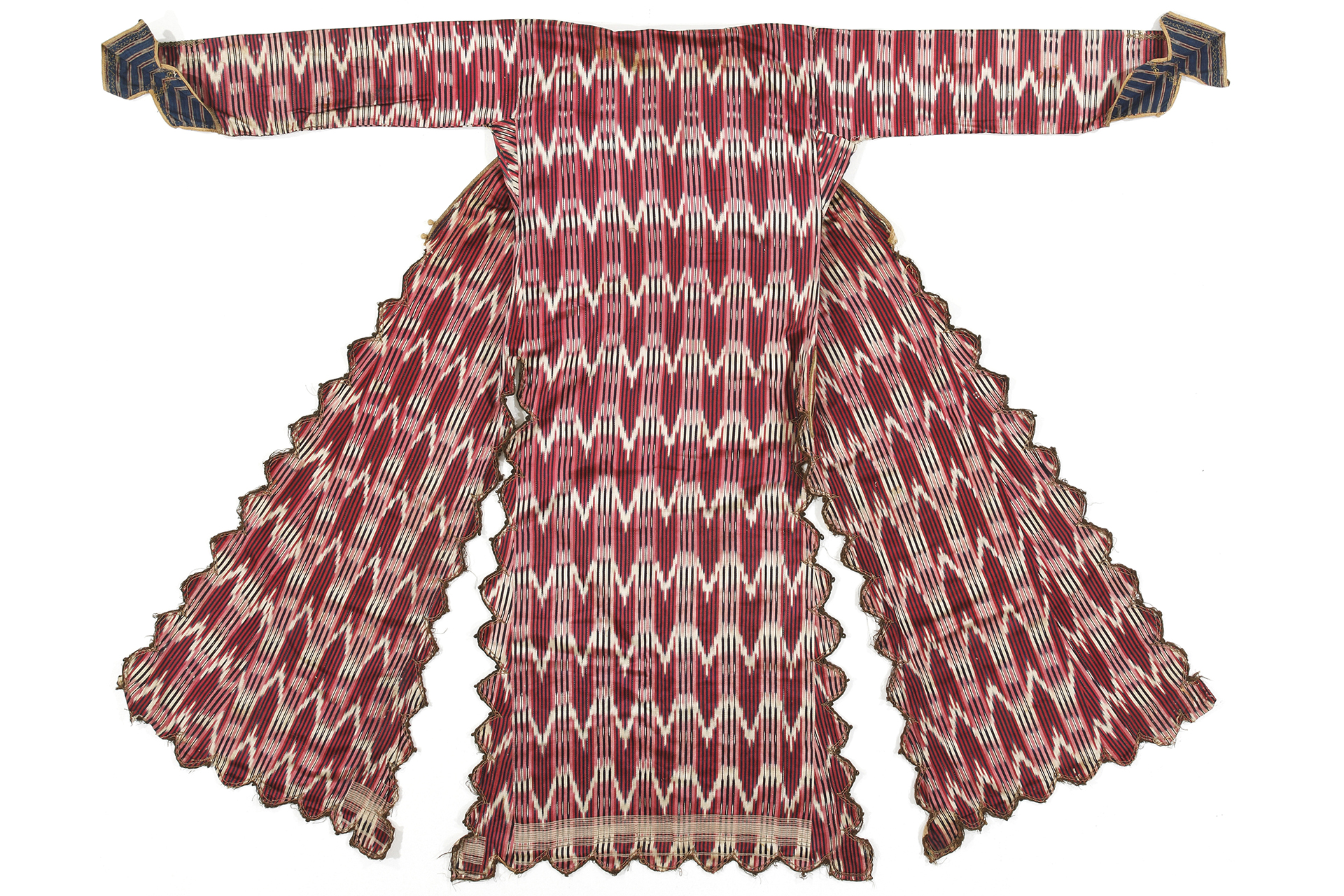MEDIA CONTACTS:
Caitlin Douglass: cdouglass gwu [dot] edu (cdouglass[at]gwu[dot]edu), 202-994-6460
gwu [dot] edu (cdouglass[at]gwu[dot]edu), 202-994-6460
Chita Middleton: chita gwu [dot] edu (chita[at]gwu[dot]edu), 202-994-5593
gwu [dot] edu (chita[at]gwu[dot]edu), 202-994-5593
WASHINGTON (February 21, 2024)—The ancient and still vibrant textile patterning technique of ikat is unveiled through more than 70 superlative examples created over a millennium in Japan, Indonesia, India, Uzbekistan, Côte d’Ivoire and Guatemala in Irresistible: The Global Patterns of Ikat, on view at The George Washington University Museum and The Textile Museum, February 24 through June 1, 2024.
"Ikat, which originated independently in communities across Asia, Africa and the Americas, unfolds across two levels of our museum, where we showcase a stunning array of ikat textiles from antiquity to contemporary times," said John Wetenhall, director, The George Washington University Museum and The Textile Museum. “This exhibition demonstrates the enduring appeal of ikat in fashion and interior design.”
"Handmade ikats are among humankind’s most technically and aesthetically superlative expressions in textile art," said Curator Lee Talbot, who organized the exhibition. "While experiencing the bright colors and dazzling patterns of ikat, visitors will learn the socio-cultural significance and symbolic meanings that people across the globe have associated with these textiles."
The fascination of ikat across the ages is illustrated by a tenth-century Tiraz fragment, possibly turban cloth, from Yemen, with arrowhead and diamond motifs arranged in vertical strips, and Homage to Japan, a large and complex abstract ikat wall hanging made in 1970 by one of the 20th century's most creative and influential fiber artists, Ed Rossbach (1914-2002) of California.
Visitors are introduced to ikat technique — a method of selectively binding and resist-dyeing warp and/or weft yarns before weaving to create a pattern in the finished cloth — through diagrams of the intricate process. After viewing a map illustrating the technique’s global distribution, visitors embark on a color-coded world tour of ikat from India, Monsoon Asia, West and Central Asia, Japan, Africa and the Americas.
Show-stoppers include ram’s-horn patterned silk robes from Central Asia, worn to signify high social status; intricate cotton cloths of Borneo’s Iban people, woven with patterns of crocodiles, whirlpools and serpents to protect ritual spaces; elegant Japanese kimono and furnishings, whose technical precision communicated the owner’s wealth and prestige; a man's wrapper cloth made by Baule male weavers of Côte d'Ivoire, who developed a new style of ikat called "zaza"; and ikat apparel made and worn by Mayan women in Guatemala using backstrap and treadle looms, a practice that continues to expand today.
Works by contemporary artists and fashion designers worldwide — including a couture-runway piece by Cuban American Isabel Toledo (1960-2019), who also designed First Lady Michelle Obama's dress for the 2009 inaugural parade — underscore the ongoing appeal of ikat, as well as the global interconnectedness of diverse peoples through this shared technique. Five short films throughout the exhibition provide case studies of contemporary ikat production in India, Indonesia, Cambodia, Japan and Uzbekistan.
The exhibition takes advantage of the impressive range of Central Asian ikat found in the museum’s collections, including fragments from its Cotsen Textile Traces Study Collection, complemented by recent gifts, promised gifts and loans from David and Marita Paly of Gig Harbor, Washington.
Major support for this exhibition and related programming is provided by The Coby Foundation, Ltd., the E. Rhodes and Leona B. Carpenter Foundation, the Fund for Contemporary Textile Art, the Latin American Research Fund, the Megalli Family Endowment and Sylvia Bergstrom, Joe Rothstein and Marin Hagen. Additional support is provided by the American Conference on Oriental Rugs, Terry Adlhock and Jeffrey Hunter, Deborah M. Anderson, the Bruce P. and Olive W. Baganz Fund for The Textile Museum Exhibitions and Publications, the Contemporary Textiles Endowment, Tina M. deVries, Virginia McGehee Friend, Helen K. King, Edwina M. Nelon, Mary Jo Otsea and Richard H. Brown, Roger and Claire Pratt, Bonnie and Tom Reilly, David M. Sloan, and Pamela Tripp-Melby.
The George Washington University Museum and The Textile Museum is located on GW’s Foggy Bottom campus at 701 21st Street, NW, in Washington, D.C., just blocks away from the Smithsonian Renwick Gallery, the White House, Kennedy Center and the National Mall. Galleries are open to the public Tuesday through Saturday from 10 a.m. to 5 p.m. Admission to the museum is free.
For the most up-to-date information on the museum's visiting hours, exhibitions and educational programs please check the museum website.
Guided tours, as well as public programs, some listed here, explore themes from the exhibition. Browse upcoming programs.
Member Programs: Tours of Irresistible: The Global Patterns of Ikat
Friday, February 23, 1-2 p.m.
Saturday, February 24, 11 a.m.-12 p.m.
(In person)
Museum curators Shelley Burian, Sumru Belger Krody and Lee Talbot will guide members through Irresistible: The Global Patterns of Ikat in a tour highlighting artworks spanning Asia, Africa and the Americas.
Exhibition Program: Lesser Known Ikat Traditions
Thursday, February 29, 10 a.m.-12:30 p.m.
(Virtual)
In this virtual gathering, scholars and artists who contributed to the book Global Ikat: Roots and Routes of a Textile Technique examine some of the lesser-known ikat traditions, including examples from the African continent, Laos and Thailand, and new interpretations by contemporary artists.
To participate, please register online.
Gallery Tours
For in-person gallery tours led by experienced docents for a group of up to 20 people, submit an online request at least three weeks in advance.
-GW-


